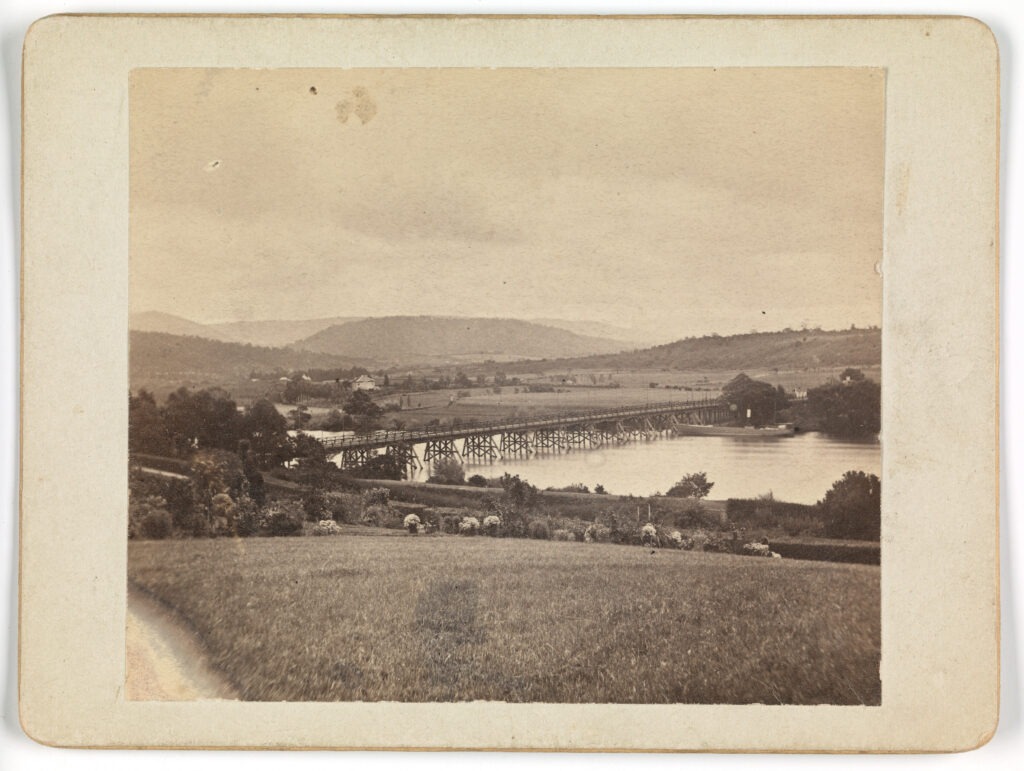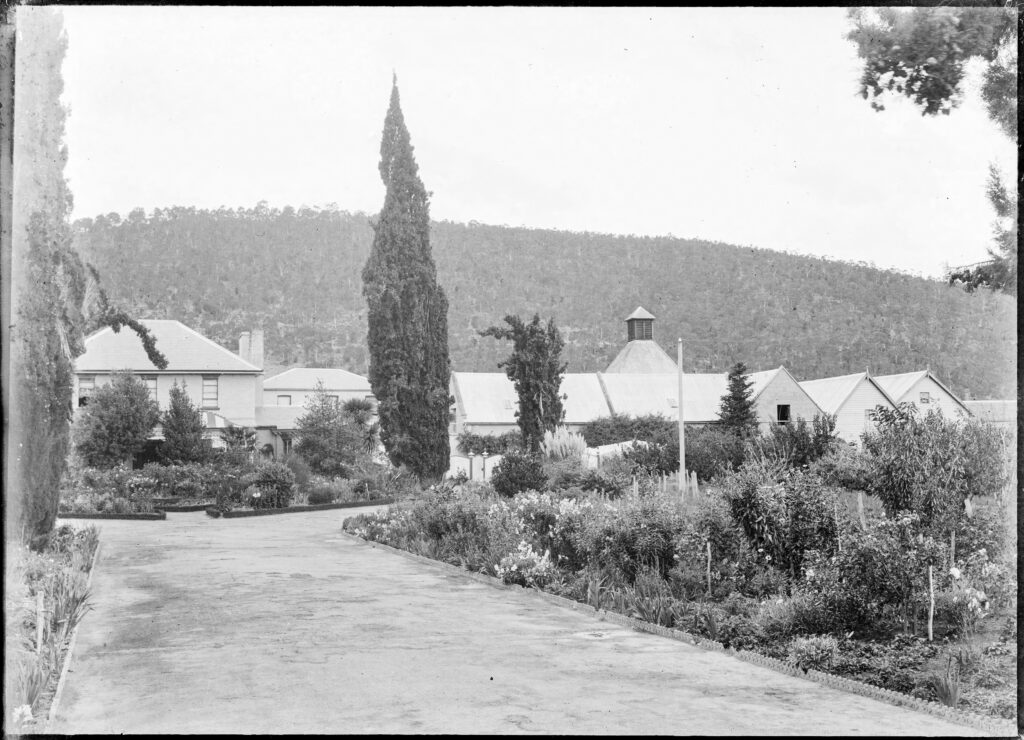Our story

The First People
The countryside of the Derwent Valley surrounding Glen Derwent was first occupied by the Leenowwenne clan, one of the five clans of the Big River Nation. They lived in the Derwent River valley for tens of thousands of years before the arrival of Europeans.

The Cullens
When the evacuation of the Norfolk Island colony began in 1807, some of the former convicts farming on the island were granted land along the banks of the Derwent River as compensation. One of these farmers was James Bryan Cullen, an ex-convict “first fleeter” who left Norfolk Island in the “Second Embarkation” on the Porpoise on 26 December 1807. Cullen received a grant of land of 65 acres, probably in 1808, part of which Glen Derwent now occupies.
We have met many Cullen descendants at Glen Derwent since 2016.
We have permission to share here an e-book “A Jockey’s Journey” compiled and edited by Jon Fearon and Stan Keough.
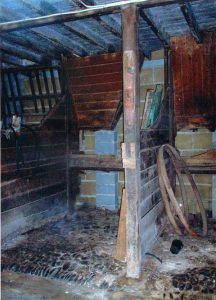
First Building
The oldest structure at Glen Derwent is the sandstone building that houses the stables and hay loft. This building is thought to have been the original cottage occupied by Cullen and his wife, Elizabeth Bartlett, and their three children Sophia, Catherine and Elizabeth, until the larger house was built. The National Trust have advised that this building may date from as early as 1808, just 4 years after the settlement of Hobart, making it one of the oldest surviving buildings in the Derwent Valley.

Main House
As the Cullens’ farming expanded, they built the large sandstone barn, coach house and carpenters loft and the main house by around 1818.
Illustration credit: Cathrine Baker
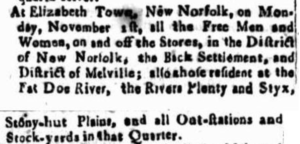
General Muster
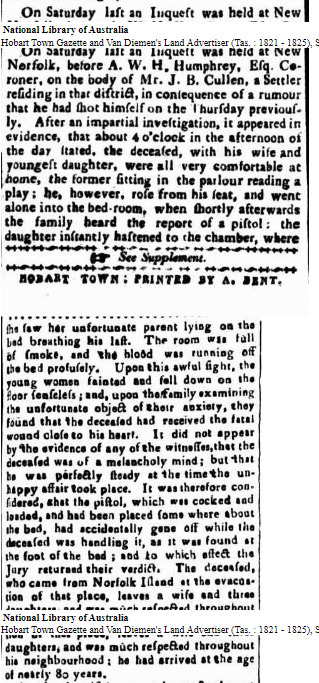
Cullen Dies
Cullen died in April 1821 aged 79 when he shot himself with a pistol. An inquest found that he had accidentally shot himself in the chest. At the time of his death he owed the considerable sum of 104 pounds 7 shillings and 2 pence to George Read, although it is worth noting his estate was worth considerably more. Cullen had not made a will and his wife Elizabeth applied for Letters of Administration in 1821. These were granted in 1824 Elizabeth struggled to immediately pay claims against her husband’s estate, having to sell their second grant of 40 acres surrounding Peppermint Hill across the river, to clear her late husband’s debts. The original 65 acres and the house were then leased to Thomas Triffitt.
The King of Prussia Inn
The property was sold to Judah Solomon in 1829 and a licence was obtained to trade as an Inn. The first licensee was a former convict named Oscar Davis, who came to Van Diemen’s Land in 1815 as a convict sentenced to 14 years for forgery. He named the Inn “The King of Prussia” after his birth place. Oscar Davis retained the licence of the Inn until 1835. It was licensed to H G Wallis in 1835 and Emanuel Benjamin in 1836.

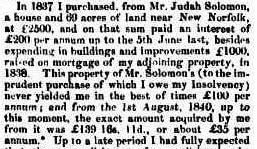
In 1837, Judah Solomon sold the property to Captain R Armstrong, owner of neighbouring property “Bingfield” (now Valleyfield) for £2,500. Captain Armstrong advertised it To Let “but not as a Public … House”, “well adapted for a school or private residence”.

The Derwent Hotel
The property remained un-let until a licence was granted to Sarah Anson from 1840-41. She named it the ‘Derwent Hotel’.
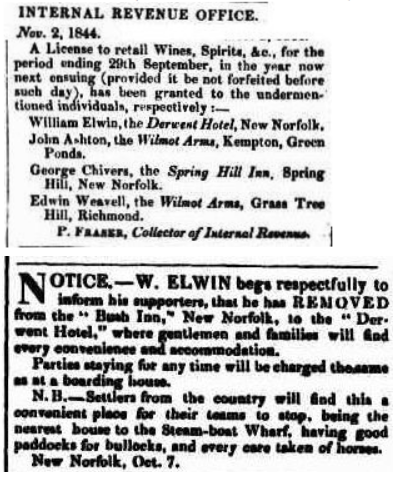
License granted to William Elwin for the Derwent Hotel, New Norfolk
NOTICE, – W. ELWIN begs respectfully to inform his supporters that he has REMOVED from the “Bush Inn” New Norfolk, to the “Derwent Hotel,” where gentlemen and families will find every convenience and accommodation.
Parties staying for any time will be charged the same as at a boarding house.
N.B. – Settlers from the country will find this a convenient place for their teams to stop, being the nearest house to the Steam-boat Wharf, having good paddocks for bullocks, and every care taken of horses.
New Norfolk, Oct. 7
Murder of Jane Saunders
Case of Miss Fenton
Elwin’s Hotel
By 1850, the hotel was known as “Elwin’s Hotel”
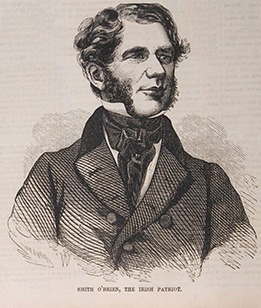
O’Brien resides at Elwin’s Hotel
William Smith O’Brien was the leader of the failed Irish uprising and rebellion in 1848. For his part in the rebellion, he was exiled to Van Diemen’s Land but being part of the educated aristocracy and a former member of the British Parliament, he was not treated as an ordinary convict, more as a political exile. In his book The Great Shame, Thomas Keneally describes O’Brien as “the Mandela of his age”.
For most of O’Brien’s time in Tasmania, he lived comfortably under a ticket-of-leave in New Norfolk.
Based at Elwin’s Hotel (now Glen Derwent), O’Brien wrote “I have established myself at a very quiet comfortable inn where I have a bed room and a sitting room and in which I am to be boarded and lodged at a rate of six pounds per month of four weeks.”
Colonel George Mundy wrote “the little rural inn where Mr O’Brien at present lodges, is prettily situated on the left bank of the Derwent, amid fruit, flower and hop gardens, with a neighbourhood of well-cultivated farms backed by wooded hills. It may be likened to a villa on the Upper Thames, with a climate of eternal summer and autumn.” (G. Mundy, Our Antipodes, London, 1855, pp. 496-7)

For Sale
From April to July 1843, the property was listed for sale as the Capacious Dwelling known as Elwin’s Hotel, with 69 Acres of Land, bounded by the Derwent and the road to Hamilton.
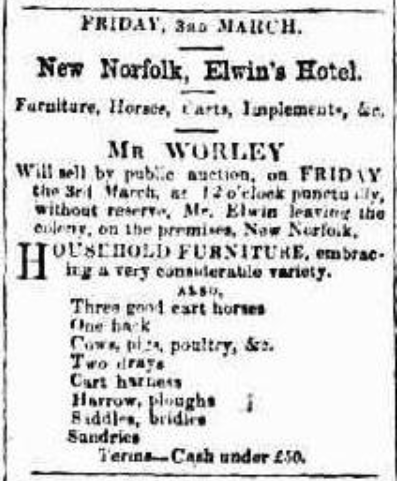
Elwin leaving the colony
A century of the Downie Family
William and Mary Downie purchased Elwin’s Hotel in 1854, renamed it “Glen Derwent” to reflect their Scottish heritage, and the Downie family successfully farmed the land and lived in the house for the next 106 years. To this day, descendants of the Downies continue to have pastoral interests in the Derwent Valley

Hop farming
During the Downie family’s time, Glen Derwent was an extensive hop farm, with the hop kiln being built in 1870. Other evidence of the property’s hop growing past is in the large cast iron gate valves that can be seen in paddocks, and closer to the house near the mulberry tree next to the tennis court. In the western paddock on the southern end, a slightly raised bank can be seen running between the valves. This was to retain the water for the flood irrigation of the hop fields. The open channel beside the tennis court carried water, pumped up from the river. As the hop industry declined after the Second World War, The Downies gradually changed to dairy farming, and parts of the land were sold. The property once extended over the highway and included land that is now the New Norfolk Golf Club.
From ‘The Mercury’
From ‘The Mercury’
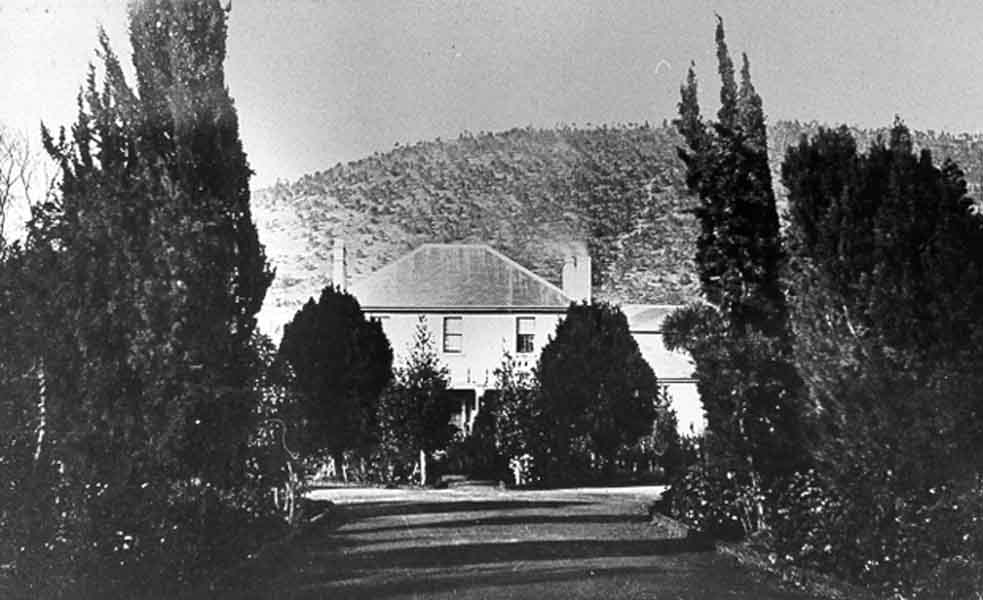

Main house showing pre-Victorian verandah. Alan and Charles Downie in the garden.
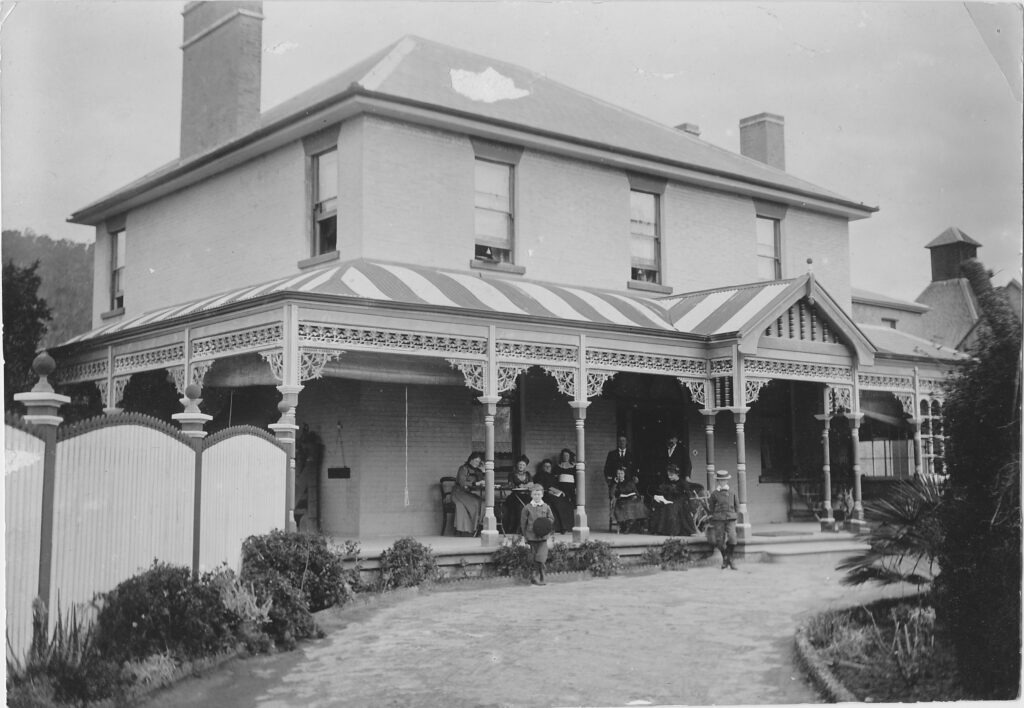
Downie family on the Victorian verandah of the main house
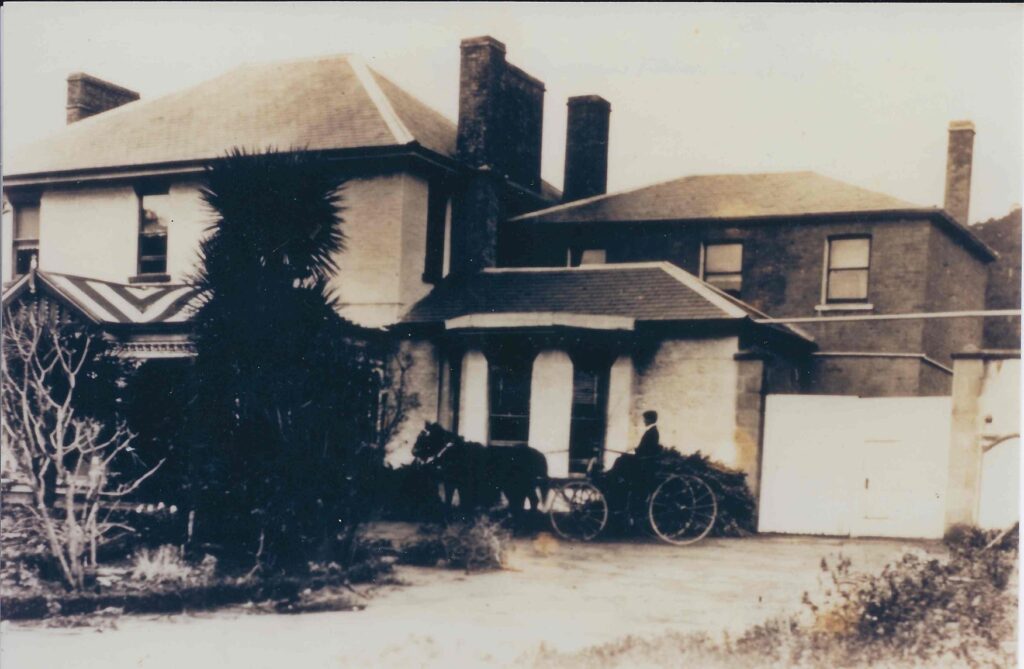
On 11 March 2018, we met Downie descendant, Nina, in our tea rooms and she kindly let us scan this photograph she thinks was taken in about 1901. At that time, Glen Derwent was owned by Archibald and Jane Downie nee Terry.
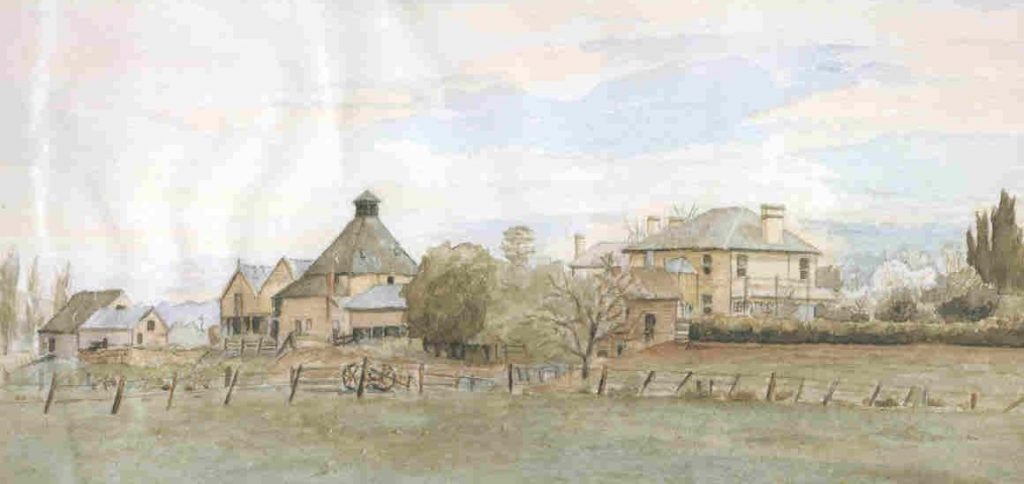
1942 Distant View by C T Downie showing the original hop kiln cowl and several since-removed outbuildings
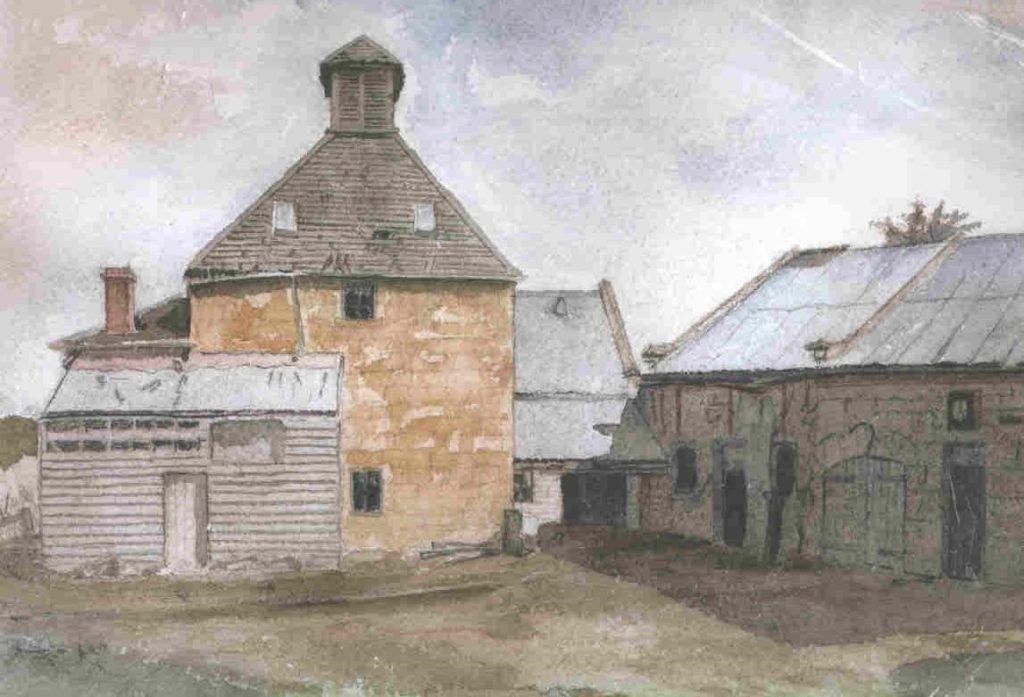
1942 watercolour painting by C T Downie
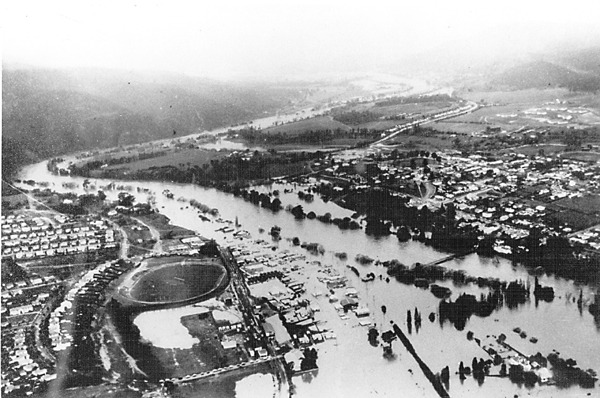
Flood
Monochrome photograph of the Derwent River flood at New Norfolk in April 1960 showing Glen Derwent in the bottom right corner (Pauline Plunkett Collection)
Archibald T W Downie (great-grandson of William and Mary Downie) and his wife Nancy sold Glen Derwent and moved to Gretna, close to where his Downie ancestors first settled in 1822, to take over Clarendon, another historical home and property.
In 1961, Glen Derwent was purchased by Keith and Jean Oakley of Lachlan, both descendants of early pioneers of that area. They ran the property as a dairy, with part of the house converted to flats, until the property was put up for sale in July 1989.
Renewal
Malcolm and Barbara Lewena purchased the property in 1989 and immediately commenced restoration and conversion of Glen Derwent to provide tourist accommodation. Work on the Main House, Tank Cottage and Master’s Stable was completed in 1990. The restoration was consistent with the colonial craftsmanship and methodology used in the construction of Glen Derwent. Their son Stuart recalled chipping in stripping back interior red cedar woodwork.
The Lewenas added to the already extensive landscaping around the house, including rose gardens around the circular drive and between the house and the road, and deepening of the natural “billabong” to create a more permanent ornamental pond. Some compromise was required for modern practicalities, since the Regency period was not known for such luxuries as ensuites with hot and cold running water. In total, 38 trades persons and sub-contracting firms were involved with 15,000 man hours spent “on site”.
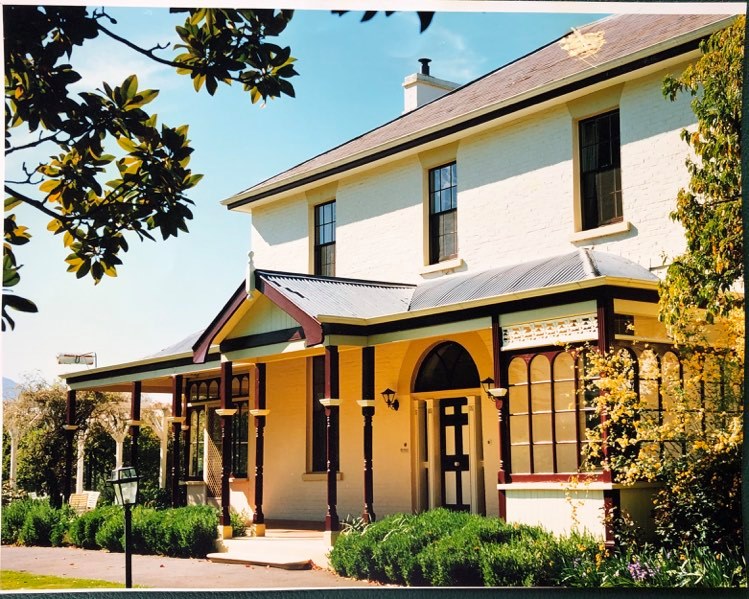
A photograph from when John and Eva Selles owned Glen Derwent. Note in the top left hand corner of the photograph the branches of the Magnolia grandiflora that was a feature of the front gardens at that time. It was during their ownership that the Magnolia unfortunately snapped and fell.
Owners D and S Grubb
Bed and Breakfast
Carol and Stan Durkin purchased the property in December 2002 and ran it as a successful bed and breakfast until they sold it in 2009.
Glen Derwent became a private residence after about 20 years of being run as a business.
The Virtue Restoration
Rob and Liz Virtue purchased Glen Derwent in November 2016 and began a restoration of the house, outbuildings and grounds to their former glory. Along with more prosaic works, such as updating fire safety and hot water systems, restoration has included removing carpets and exposing the original, albeit somewhat paint-spattered, pit-sawn floorboards, held down by hand-forged iron nails. Ongoing works include once again re-stripping and polishing the red cedar and Huon pine joinery and restoring rooms to their original colour schemes.
The initial works in the gardens started with clearing the waist-high grass, hemlock and blackberry. This work has been akin to an archaeological dig exposing Incan ruins. Hidden beneath the overgrowth were old sandstone steps and retaining walls, some dating back to the original convict construction, and later pathways, ponds and iris beds planted by the Lewenas and Durkins.
A decidedly non-Georgian and little-used swimming pool set in to one side of the front lawn has been removed and replaced by a parterre garden, more in keeping with Regency aesthetics. This has been planted with annuals and roses to complement the slowly recovering remnants of the formerly extensive rose gardens.
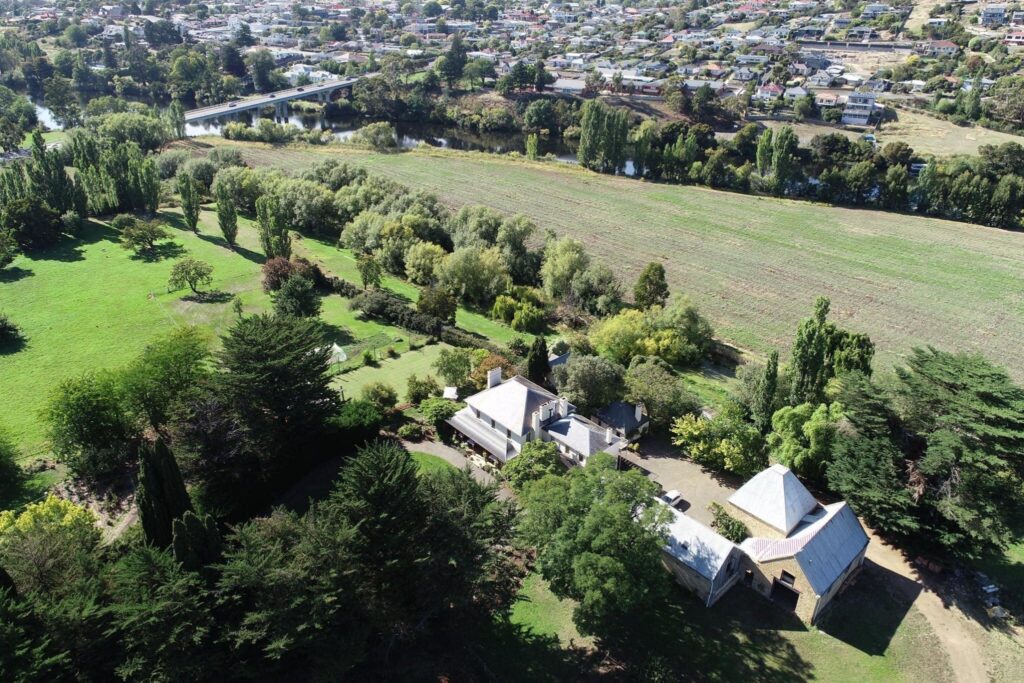
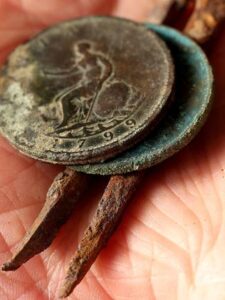
1799 English halfpenny found under the Drawing Room floor during restoration works

A tobacco pipe found concealed between two bricks in the roof of the main house.
Historian Ian Evans told ABC Hobart the pipe was the first he’d seen concealed in such a manner anywhere in Australia.
“I thought it was very clearly a deliberate concealment of an artefact, the purpose of which is to divert unpleasant spiritual beings from the humans in the house to these objects.
“If these beings could be lured into voids in a building, they would not be able to escape and therefore not be able to harm the humans who lived there.
“I’ve had truckloads of old shoes, garments, dead cats, household goods — but this is the first pipe.”
A Learning Process
We are always learning more about Glen Derwent and its history, so if you want to know something of its past or features, please ask. Conversely, if you notice some feature or have some knowledge of why things may be as they are, please tell us. We would love to know.




